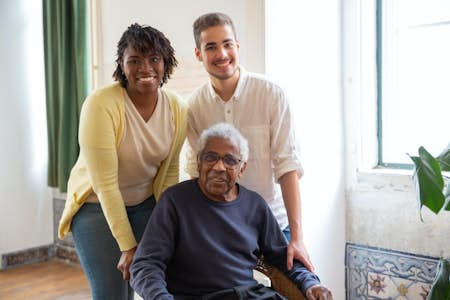In today's world, technology can provide invaluable support for primary caregivers of senior relatives. With rapidly advancing technology, caregivers can now access various tools and resources to support their caregiving duties.
Caregivers can use technology for various things, including monitoring the health of elderly family members, providing medication reminders and alerts, connecting with family members, and keeping family memories safe.
By incorporating technology into the daily routines of primary caregivers of elderly relatives, a wide range of solutions are available that make it easier than ever before for people caring for ageing parents or grandparents at home to get assistance managing their responsibilities as well as stay connected with those they love most despite the physical distance separating them.
Whether you're looking for a personal alarm for yourself or something to put your mind at rest about a loved one's wellbeing, there's something for all needs in this fantastic range of caregiving and monitoring aids.
Stay connected with loved ones - even when they're far away
Technology has made it easier for primary caregivers to stay connected with family and friends even when they are far away. With smartphones, laptops, tablets, and social media platforms such as Facebook and Instagram, primary caregivers can keep in touch with their loved ones regardless of location.
Social media can be an excellent tool for primary caregivers to stay connected with those who are important to them, even if they are miles apart. Social networks make it easy to share photos and videos and connect with others in real-time without meeting up physically.
And social media is not just for younger people. The most recent surveys by the Pew Research Centre indicate that 45% of the population over 65 uses social media.
And video chat technology has also become widely available through apps such as WhatsApp and Google Meets. This technology makes it possible for primary caregivers to have face-to-face conversations with family members or individuals who may not be near them physically but could still use some support or guidance from afar.
Approximately 61% of those over 65 now own smartphones, making video calls more effortless than ever. Video calling also gives primary caregivers a chance to show their loved ones emotional support from any distance at any given time.
Get organised - keep track of important documents and appointments
There are various tools, like online calendars that can be shared between multiple users, which can help primary caregivers get organised. These tools can help coordinate appointments or events amongst people scattered across different locations, making it easier for everyone involved to schedule plans or tasks remotely.
And emerging software solutions like eLivelihood are making it easier than ever for primary caregivers to get organised.
Jill Lindgren, CEO of eLivelihood, explained how her company’s solution could help primary caregivers monitor the needs of older family members. She said: "We allow the primary caregiver to share the burden and coordinate information with the family through a platform that keeps everything in one place, keeps everyone informed and secured with customised permission settings for each team member.
"It includes task assignment, appointment updates, Safekeeper information storage for the will, medications, health, and important information. We also include the ability to track current financial account balances without giving access to the actual accounts."
Elivelihood, a self-funded company with more than 1,000,000 paid subscribers, shows how technology can be a powerful tool in the primary caregiver’s arsenal.
Store important family memories
Keeping hold of important family memories and having the space to reminisce and connect over shared history is a vital aspect of caring for older relatives who may be at risk of memory loss.
Software like eLivelihood also offers a function that allows older adults to keep track of family memories.
Jill Lindgren added: "We include an easy-to-use free tablet application, specifically designed for seniors. It allows the family to share important memories through pictures or videos and has a messaging system for them to keep in touch with everyone, no matter where they are."
This is an example of how technology is not just a means to get organised but also a tool that can help connect people across generations.
Technology is a powerful resource for primary caregivers
Technology has profoundly improved the lives of primary caregivers of elderly relatives. It enables them to stay connected with their loved ones from afar, provides access to helpful resources and services, and even assists in planning long-term care.
It also helps caregivers better manage their own stress levels by allowing them to communicate more easily with medical professionals or other family members who may be involved in caregiving duties.
All of these benefits allow primary caregivers of elderly relatives to provide better care while managing the demands of their own day-to-day lives more effectively.












